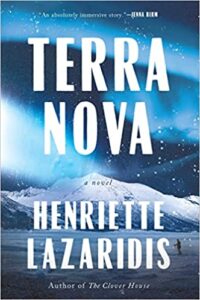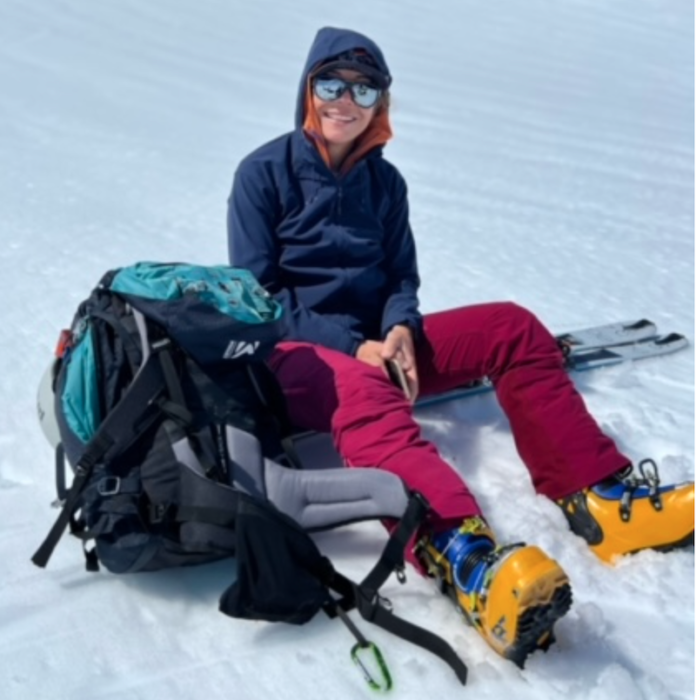We are excited to welcome author Henriette Lazardis to the blog today. First, tell our readers a bit about yourself.
I’m from New England, but not really. My parents were both Greek and emigrated to the States while in their thirties, a bit before I was born. I grew up in a Greek-speaking home, returning to Greece for three months a year almost every year until I was in my 20s. I still go at least once a year, as all my family is there. I have a son and daughter, both adults—and my daughter is in fact a novelist, too. I wrote TERRA NOVA under the expert supervision of my Golden Retriever Finn who died at 13 ½ a couple of years ago. My husband and I now have a tuxedo cat named Django after the guitarist Django Reinhardt.
How long have you been writing and is it your full time job? If not, what is your ‘real world’ job?
I was an academic for about fifteen years as my first career, teaching at the university level and serving as a teaching dean. I left academia a long time ago, and now teach creative writing (focusing on the novel) at GrubStreet in Boston. I also do manuscript consultations and run a week-long writing workshop in the summers. This leaves me enough time to work on my writing.
Tell readers what your typical writing day looks like?
A typical writing day includes some sports. As a lifelong athlete, I’m always training for something, whether it’s rowing or trail running or downhill skiing or ski mountaineering (which adds skiing uphill to the joy of the downhill). Most months of the year, I’ll get my training in first, and then sit down to write and/or teach. In winter, I like to get up at 5:00 and write until the sun comes up and then go about my other commitments with classes and writing—and finish up with a run or a session on my indoor rower, before an evening of hanging out with my husband or getting together with friends.
Tell us about your latest release.
TERRA NOVA comes out December 6 from the wonderful Pegasus Books. It’s about two fictional Antarctic explorers in 1910 and the woman who loves them both and is forging new territory of her own as a photographer working with the suffrage movement in London.
What inspired the idea for this book?
I’ve been obsessed with real Antarctic explorer Robert Falcon Scott since I was 7 years old and saw a documentary about his race to the South Pole against Roald Amundsen. I always wondered what it must have felt like for Scott to endure all the challenges and suffering of his journey only to reach the Pole and see Amundsen’s flag already there, signifying Scott had lost. So I invented two explorers who face that same situation and react to it in what I’ll simply call here complicated ways.
Which of the characters do you relate to the most and why?
Of course, I’ll say I relate to each of the three main characters! But I think it’s the expedition photographer James Watts I relate to the most. He’s an ambitious man, but he places limits on his ambition in a way that I don’t think I share, but that I find interesting. He’s wrestling with the realization that he’s not as good an artist as he thinks he is. I find his realism important—even though I’m personally less inclined to the resignation he exhibits. He has a self-destructive streak that I hope I don’t share!
Would you and your main character be friends?
The real main character of the novel is Viola Heywoud, and, yes, indeed, we would be friends. I admire her as a photographer and as an artist with ambitions she is honest about. She knows what she wants and she goes about getting it—both romantically and artistically. In the novel, Viola’s friend is Isabella Purvis, and I think I’d quite like to sit around with Viola and Izzy and debate the best strategies for women to win the rights and independence they deserve.
What part of the book was the hardest to write?
The Viola sections were the most challenging for me—and they take up more than half the novel. I went through several iterations of her story, trying to figure out how her ambition should express itself. I knew she had to be working on something while the men were away in Antarctica, but I had a hard time figuring out what that should be. Then I realized it had been staring me in the face the whole time: the suffrage movement, and the hunger strikers in particular. Once I had that, Viola’s story came much more easily.
Did you model a character after someone you know?
Nope!
Could you share one detail from your current release with readers that they might not find in the book? Perhaps a juicy bit of back-story, or something only you know about a character?
Samuel Miner is the former climbing partner of Edward Heywoud and James Watts, though he is more on the level of assistant than peer. In the novel, the reader learns that he fell into a crevasse on Mont Blanc while climbing with them and suffered frostbite that cost him his nose and part of one of his feet. What the reader doesn’t know is that, after Heywoud hired him as household retainer/butler, Miner resented Viola at first, for not being a part of the world he shared with her husband and her husband’s friend, and for essentially domesticating him as he was tasked to watch over her. He probably suspected, too, that she was having an affair with Watts. But over time, Miner develops a deep affection for Viola that grows almost to the level of a crush.
Are there any particular authors that have influenced how you write and, if so, how have they influenced you?
Weirdly enough, Charles Dickens’ method is always in the back of my head as the approach I aspire to. As a former Dickens scholar in my academic life, I’m fascinated by the way he drew up his notes for his novels. I love his combination of plotting things out and writing by the seat of your pants. He’s the consummate “plantser”. I try to follow a similar half-plotted/half-mysterious-to-me approach to my own writing.
Then there is Zadie Smith, whose writing about how she writes is unsurpassable (as is her fiction). And Kate Atkinson, whose novels give me something to aspire to even as I know she is utterly and completely out of reach. Smith and Atkinson are, for me, examples of truly great writers. Having them to look out toward is a constant reminder of how much more I can and should push myself to craft my best fiction.
Any writing rituals?
I change my rituals up all the time. My favorite, though, is the winter ritual that goes like this:
Wake up at 5:00, don’t turn on any lights, make the coffee and grab two digestive biscuits, sit at the dining table with only the light on over my head and set at just bright enough to prevent blindness, remove glasses, bend low over notebook, write with Kaweco Sport fountain pen until the sun comes up. I love writing in the dark and before the house is awake. It’s a way to preserve the dream of the fiction. Then, after breakfast and a workout, I’ll type up the hand-written words into a Scrivener doc and revise a little as I go.
What’s your favorite under-appreciated novel?
Tom Drury’s The End of Vandalism is a perfect novel everyone should know about. I believe most of it was published as short stories in the New Yorker, and it does have the laconic style we associate with the magazine. What’s great about it is its humor and its deeply empathetic heart. The central story sneaks up on you after pages and pages when you think you don’t have a main character to follow—and then you realize you’ve been caring deeply about Drury’s characters the whole time.
Do you have a secret talent readers would be surprised by?
Well, I’m not sure I can call it a talent yet, but, after a lifetime of piano and guitar and voice, I’ve taken up the mandolin, which I just love.
Your favorite go to drink or food when the world goes crazy!
Popcorn. But then I don’t need the world to be crazy. I make it almost every night—not the microwave kind.
And what is your writing Kryptonite?
If music is playing in the background, it’s almost impossible for me to concentrate. I can’t help paying attention to the music, whether I recognize it or not. This is why I have a hard time writing in coffee shops, unless the din of conversation drowns the music out.
What is the one question you never get asked at interviews, but wish you did?
Q: If you had to choose one other art form to excel at, besides writing, what would it be?
A: Acting. I’ve loved to act since I was a kid doing school plays. I’d love to be truly good at it and be able to create art with my whole self—emotions, mind, body, voice. The closest thing I come these days is reading my work aloud, when at least all us writers get to be performers for a little bit.
Thank you so much for joining us today, Henriette!
Here’s a look at TERRA NOVA releasing December 6th:
 A haunting story of love, art, and betrayal, set against the heart-pounding backdrop of Antarctic exploration—from the Boston Globe-bestselling author of The Clover House.
A haunting story of love, art, and betrayal, set against the heart-pounding backdrop of Antarctic exploration—from the Boston Globe-bestselling author of The Clover House.
The year is 1910, and two Antarctic explorers, Watts and Heywoud, are racing to the South Pole. Back in London, Viola, a photo-journalist, harbors love for them both. In Terra Nova, Henriette Lazaridis seamlessly ushers the reader back and forth between the austere, forbidding, yet intoxicating polar landscape of Antarctica to the bustle of early twentieth century London.
Though anxious for both men, Viola has little time to pine. She is photographing hunger strikers in the suffrage movement, capturing the female nude in challenging and politically powerful ways. As she comes into her own as an artist, she’s eager for recognition and to fulfill her ambitions. And then the men return, eager to share news of their triumph.
But in her darkroom, Viola discovers a lie. Watts and Heywoud have doctored their photos of the Pole to fake their success. Viola must now decide whether to betray her husband and her lover, or keep their secret and use their fame to help her pursue her artistic ambitions.
Rich and moving, Terra Nova is a novel that challenges us to consider how love and lies, adventure and art, can intersect.
Find out more about Henriette and her books at:
Visit her website: https://www.henriettelazaridis.com/
Instagram: @writerhenriette, @entropyhotel
Twitter: @writerhenriette
Facebook: @HenrietteLazaridis
Substack: https://henriettelazaridis.substack






